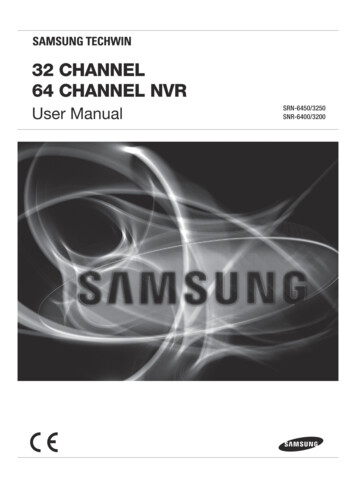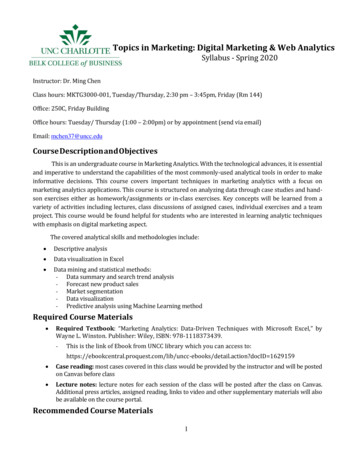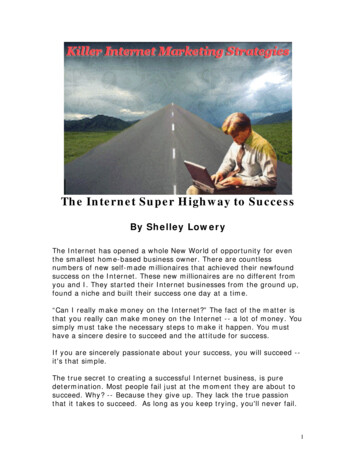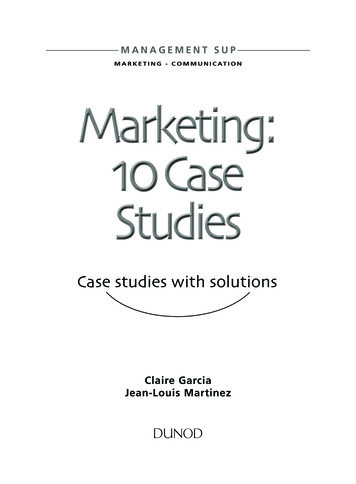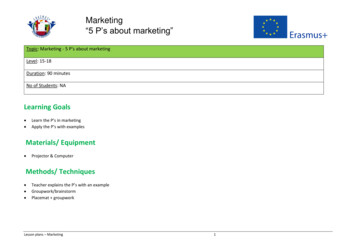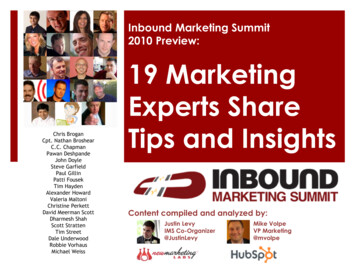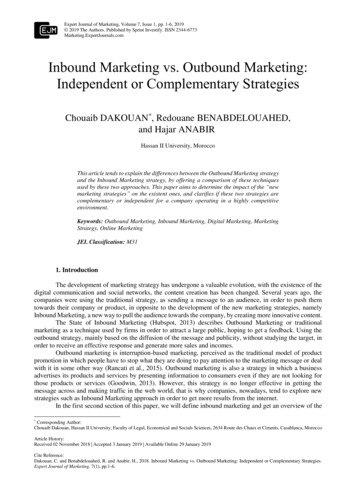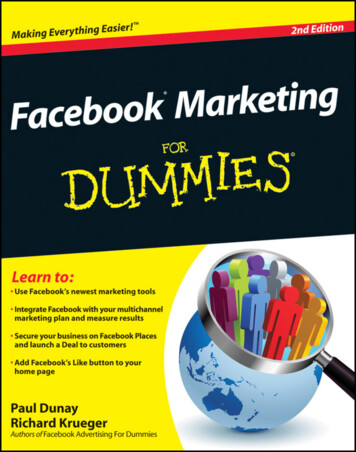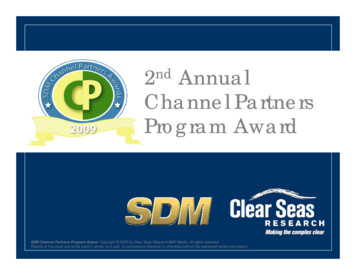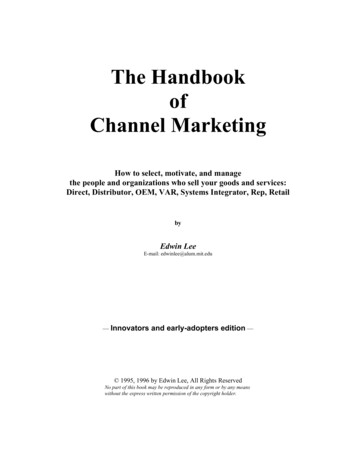
Transcription
The HandbookofChannel MarketingHow to select, motivate, and managethe people and organizations who sell your goods and services:Direct, Distributor, OEM, VAR, Systems Integrator, Rep, RetailbyEdwin LeeE-mail: edwinlee@alum.mit.edu— Innovators and early-adopters edition — 1995, 1996 by Edwin Lee, All Rights ReservedNo part of this book may be reproduced in any form or by any meanswithout the express written permission of the copyright holder.
ToArnold JorgensenAn engineering craftsman, a recreational adventurer, my mentor, and my friend.i
ii
ThanksThanks to Rich McClellan, Mike Campo, Jack Blakemore, Jeff Blackden, Larry Reierson, Jeff Miller,George Satterthwaite, Peter Benedikt, Ted Lusk, and Bruce Michels for diligently reviewing early draftsof the book and for providing me with so many helpful comments and suggestions on how to improve it.Thanks to Tom McCall, Brad Paul, Dave Paul, Bob Dietz, Tom Eisenstadt, George Rozzaza, Ron Ferara,Jerry Horrowitz, Pete Rocco, Rich Kelliher, Dennis Jordan, Ken Ericksen, Kathy Ericksen, Mary Pim,and many others for sharing so generously about their Sales Representative, Distributor, and VARbusinesses, and for their many encouragements.A special thanks to Bob Dietz, founder of the Association of High Technology Distributors. He enabledme to join that organization and to experience the world of hi-tech selling from the perspectives of itsmembers.A singular thanks to my mother, Betty Lee, who has rigorously edited this book twice; enthusiasticallycorrecting her son’s occasional misuses of the king’s English. Any mistakes that you find were probablycreated after she finished editing.Rev: November 10, 1997iii
iv
Table of ContentsThanks.iiiTable of Contents. vAuthor’s Foreword. 1Introduction. 3Who can use this book?. 4Overview . 5Section I: Methods and Tools1. Defining the Objective. 9What is a Marketing System?. 9When is it Successful?. 10The Six Cornerstones of successful business partnerships. 13Exercises. 162. How to Produce the Objective . 17The learning process: through complexity to success . 17The Scientific Method: our problem solving tool . 19Commentary on the process . 22Using it to design and manage a Marketing System . 24Short Cuts . 26Exercises. 263. How to Motivate and Manage Decisions. 27Maslow’s Hierarchy of Personal Needs . 27The need for fun . 28Management by Personal Attractors . 29A Personal Attractor’s pull. 30Money and Personal Attractors . 32Competitive Alternatives. 33The Principle of Three to Five. 34Reasons to manage by Personal Attractors. 36The bottom line . 37Exercises. 374. Decision-making Attitudes . 39Overview . 39Adventurers . 41Craftspeople. 43Bureaucrats . 44Victims . 45v
Other attitudes . 45Market timing for Adventurers, Craftspeople, and Bureaucrats. 46Impact on selling . 46Exercises. 475. Customers’ Buying Processes. 49The buying team. 49The buying process . 50Shortcuts in the buying process. 54Timing of the buying process . 55What customers want or need. 57Timing of goods and services. 61Exercises. 636. Customer/Supplier Relations . 65Relative importance of Customers and Suppliers. 65Critique of “the Customer is King” . 67The desired outcome: Profitable Customers. 68The bottom line . 707. Manufacturers’ Selling Processes . 71Selling sequence . 71Timing of the selling process . 75Summary . 76Exercises. 76Section II: Channel Organizations8. Introduction to Sales Channels . 79Direct . 80Manufacturers Representatives . 81Distribution. 82Value Added Resellers . 83Other Channel Resources . 86Classifying organizations is tricky . 87Exercises. 879. Direct Sales . 89Structures. 89Key people. 92Economics . 94Strengths. 95Weaknesses . 95Management issues. 96Best customers. 97Worst customers . 97Exercises. 97vi
10. Manufacturers Representatives . 99Structure . 99Key people. 99Economics . 103Working relationships . 109Strengths. 110Weaknesses . 111Management issues. 111Best customers. 112Worst customers . 11211. Distributors . 113Structures. 113Key people. 114Economics . 115Working relationships . 115Strengths. 115Weaknesses . 116Management issues. 116Best customers. 118Worst customers . 11812. Retail . 119Shelf Space . 119Structures. 120Key people. 120Product Packaging. 121Economics . 121Strengths. 122Weaknesses . 122Management issues. 122Best customers. 122Worst customers . 12213. Value Added Resellers. 123Structures . 123Key people. 124Economics . 125Working relationships . 125Strengths. 126Weaknesses . 126Management issues. 126Best customers. 127Worst customers . 127vii
Section III: Where the Rubber Meets the Road14. How to Design Your Marketing system . 131Where we are in the design process . 131Simplifying Principle #1 . 131Simplifying Principle #2 . 132Eight Questions that shape your Marketing System . 133Summary of values added by channel organizations. 139How to develop a Marketing system from scratch . 140How to optimize an existing system . 142Guidelines for adding channels . 14215. How to Hire Sales Professionals and Channel Organizations . 143General approach. 143Interview and hiring tips. 144Interviewing Sales Executives. 145Interviewing Reps or VARs . 146Use the old-boy network . 149Eight common mistakes . 150Exercise . 15116. How to Get Them to Sell for You. 153Background . 153Plan Overview . 154Plan Objectives. 154Plan Sequence. 156First training session. 15617. Eight ways to Keep them Selling for You . 1591. Provide dependable, timely support . 1592. Build on strength . 1593. Have the best sales professionals visit the factory . 1614. Publicize competitive ratings among top performers. . 1625. Conduct participative and interactive sales meetings. 1626. Establish a “Top Sales Professionals” council . 1647. Establish a Council of channel organizations. 1648. Establish an effective and continuous training program . 16518. A Fresh Look at Classic Issues . 167What makes the Sales Forecast counterproductive . 167Individual Quotas and Incentives . 170Launching New Products . 17119. Automating Your Marketing system. 173Examples of effective automation . 173Eight tips on how to automate . 174Suggestions for computer-resistant executives. 177viii
20. Those Nasty, One-sided Agreements. 179Principles of agreements. 180Elements of channel agreements . 181Objectives of channel agreements . 182Usual signing procedure . 182Suggested signing procedure . 183Sales Representative agreements. 184Distributor and VAR agreements . 18821. Managing Channel Conflicts . 191Examples of conflicts . 191Origins of conflicts. 193How to manage conflicts . 19622. Seven Ways a CEO Can Increase Sales. 2011. Visit customers and channel organizations . 2012. Require other corporate executives to visit the field . 2033. Actively and formally listen to sales professionals . 2044. Convey personal thanks to top performers . 2045. Review channel agreements and how they are administered . 2056. Replace win-lose forecasting with proactive planning . 2057. Sponsor an ongoing sales-training program . 205Appendix ARecommended Reading . 209Sales and Marketing . 209General . 209Menu of Services, M&D Controls CompanyEssaysDo You Compete With or Compete Against?Effective and Meaningful JobsThe Computer as God?ix
x
Author’s ForewordThirty years of personal experience led to this book. So did the help and support of many people, includingsales and marketing professionals from all over the country. This is the book we needed when a group of us,technologists all, started our first company.I am an engineer and an entrepreneur who learned how to market and sell as the need arose. I founded twosuccessful high-tech companies and two other learning experiences. The successful companies are Pro-LogCorporation, which makes industrial computers, and MSI Data Corporation, which made order entry systems.The other learning experiences were Drag Mag, a toy company, and Digital Devices, maker of test equipmentfor capacitors.Digital Devices was my first entrepreneurial endeavor. In the early 1960s, we four engineers worked nightsand weekends out of a garage, while employed full-time at a computer company. I had designed a piece oftest equipment that no one else had been able to make, and we learned the hard way that the world market forour 5000 instrument was 30 units. After two years of hard work at no pay, we sold three units, broke even,cleaned out the garage, and resumed a more normal existence.Several years later, two of us from Digital Devices teamed up with a third person and started MSI DataCorporation. This time we identified a sizable market first: the supermarket industry. Then we found aproduct it needed in large quantities: order entry systems which supermarkets used to order groceries fromtheir wholesalers via the telephone. Then we designed and sold the product. I was the VP of Engineering. Iled product development, helped close the initial sales, found the SBIC (Small Business InvestmentCorporation) that financed us, and established our nationwide field service organization.MSI was very successful for a few years, went public, and was eventually acquired by a competitor. However,the three of us who founded it disagreed strongly among ourselves about how to
Sales and Marketing.209 General .209 Menu of Services, M&D Controls Company Essays Do You Compete With or Compete Against? Effective and Meaningful Jobs The Computer as God? ix . x . Author’s Foreword Thirty years of personal experience led to this book. S
